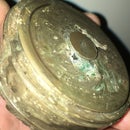Introduction: a Green Alternative Fertiliser From Urine
“The average person flushes the toilet five times a day, and four of those times are just for urine. This means that 80% of our flushwater—or over 4,000 gallons of clean water each year per person—is used just to get rid of urine! That is a lot of clean water used to transport ‘liquid gold’ into the sewer, where it becomes pollution.
Why is our urine so valuable : It contains phosphate Nitrogen & minerals of course - Why you may ask- We'll our endoskeleton is made from a matrix of CaPo4 and other minerals. Our daily uptake from the foods we eat maintains the necessary levels of minerals including Calcium & Phosphate.
Saving on resources- Even though urine is sterile when it leaves our body, within hours of exposure to the air it starts to putrify. The Urea [CO2 (NH2)2] present in our urine which we excrete, breaks down into Ammonia and Carbon-Dioxide. This is why a urinal smells so much, especially in the warmer seasons. When this waste hits the Water-Treatment Plants that Purify and Desalinate our Tap Water, it causes many problems.
The problem being a chemical byproduct that forms when the Phosphate also in urine bonds to the Ammonia and a Metal Ion like Magnesium to form [Sruvite]. Struvite diposits, as a type of Lime-Scale but it is Magnesium Ammonium Phosphate. This Product causes havoc with all the plumbing and filtration systems that help to make our Tap-Water fit for consumption.
The Phosphorous Cycle.......
Throughout our body Our Blood, Tears, Urine, Saliva, intestine and stomach all have varying PH -
Potential Of Hydrogen [1-14 ]1-6=Acidic - 8-14=Alkaline 7=Neutral
Acidic parts of the body like the bladder and Intestines kill germs and prevent infection so urine is slightly acidic. Saliva and Tears are Alkaline. Our blood is nearly Neutral like Clean Water. However If our lifestyle choices cause us- to be Stressed or have an unbalanced Diet - like the over consumption of Alcohol, Meats and lack of appreciable hydration it can push our bodies in either direction.
We can become either too Acidic or too Alkaline the condition is called Alkalosis & Acidosis.
The good thing is Nature is smart, our body is able to regulate and offset these conditions to a degree- if we become too acidic Our body will release Calcium / potassium /magnesium from Our Bones & Teeth & organs, In order to maintain the ideal ph.
This is why we excrete Phosphorous and like all other forms of life, we excrete Nitrogen through metabolism, (the breakdown of organic matter through respiration).
Please site for more in depth explanation, as I have only given a very basic coverage of these very scientific areas.
Step 1: A Historic Use of Urine and Our Instructable.
In the advent of Gunpowder. A notable European method of making Nitrate Of Potash was formulated from the construction of Nitre Beds. A type of compost heap, composed of layers would be constructed. The layers consisted of Straw, Soil/ manure, Chalk/ Wood ashes, a pile was typically around 2sqMeters in width and twice as high. It would then be left to decompose for about a year whilst under cover during which time, it would be kept moist with putrified urine and aerated to aid anaerobic decay. Having been left to rot for a year or more, the crude nitrate of chalk & magnesium would be extracted using water.
the resulting liquid would then be mixed with potassium carbonate from wood ashes to precipitate unwanted chalk & magnesium nitrates as carbonates ,which would otherwise cause the nitrate to be hygroscopic.
After filtering, the mother liqueur would be boiled down to a concentrate and left to crystallise out - it would have to be re-crystallised several times until, clear 1" long needles were formed. Then I would be dried and ready for Gunpowder production.
Hennig Brand (c. 1630 – c.1692 or c. 1710) was a merchant and alchemist in Hamburg, Germany. He discovered phosphorus around 1669 whilst in the pursuit of a substance which held acclaim by alchemists, ' the Philosophers Stone'.
Like other alchemists of the time, Brand searched for the "philosopher's stone", a substance which supposedly transformed base metals (like lead) into gold. He tried various routes of experimentation, when one day he thought it would be a good idea to boil several litres of urine down to a paste. He then used a glass retort to super heat it. Which caused it to vaporise so it could be collected, to his amazement it spontaneously combusted whilst exposed to the air.
His gold being phosphorous which he named after the Greek word meaning " light bearing" it eventually found its use in matches, tracer material, inside television screens etc etc.....
IN THIS THE INSTRUCTABLE................We are going to be conducting some interesting chemistry & touching on biology......Whilst using some age old extraction techniques. We will be extracting the enzyme Urease from [SOY], which hydrolyses urine into ammonia and Carbon dioxide. Then we will precipitate out the Phosphorous alongside ammonia with a metal Ion MgCl.
Step 2: Materials Necessary for Our Plant Food
Small handful of dried soya beans
Distilled / Deionised water
Magnesium chloride or Make from [Magnesium carbonate + Muriatic acid]
2 large glass mason jars & 2 Small jam jars
Filter paper / Coffee filters
Stiring rods
Digital gram scale.
Latex Gloves
And in the name of science ( A good litre) of fresh [Morning Urine]....
Pestel & Mortar
PH Testing strips [Litmus Paper]
Step 3: Extraction of Urease From Soya Beans
Step 1) First we soak a handful of beans for 6-8 hours, or overnight it's up to convenience really
Pic 1) Beans are mashes with a pestle & mortar until we have a fine mash ( smell is quite appealing ) I found if you have enough patience to gently pinch each been between finger & thumb, the outer skin pops off.......it makes mashing easier when using Pestle & Mortar---[If not using food processor]....
Pic 2) Add left over water to the mash to free a milky liquid. If you add more water [say double] it is easier to sieve. YOU can however let settle and spoon it out rather than sieve it..........
Instructions below are optional!!!!
Pic 3) Construct a funnel and filter material. I did find this stage very slow - but it can be spead up a little.
Pic 4) Put a glove around the funnel and double tie elastic band as to compress air through mash and release liquid. You could use a Spoon And Tea strainer instead !!!!! As liquid is very viscous.....
Pic 5) Filtrate is milky and contains the Enzyme that causes catalysis of urea. Add approximately 20ml per litre of urine.
Step 4: The Process of Hydrolysis & Precipitation
For 1L -Take a 10 Soy Bean and Soak in a little Water over night to re-hydrate them -Liquidise or Pummel with Pestel & Mortar, then add a liilte water left from soaking. You should have about 50-65ml of milky liquid. See instruction on previous chapter..........
Hydrolysis :Take your first wee of the day [Morning] and put in a jar for this to yeald appreciable amount you can keep topping upduring the day or get someone elses if they do not mind but I always used my own. You need at least a Litre 1000ml. Test the PH with indicator strips [Litmus paper].PH should be 6.5-7.
Next: We add the milky Soya Extract to the Urine, Cover and keep warm for about 18 Hours... If after this time you can notice a strong odour of ammonia we are about ready - alternatively test the PH and compare -it should be high PH alkaline. & be 9.5-10
Primary Struvite Precipitation As the Ph increase Struvite will begin to settle out of solution because Magnesium & Calcium Is already present. Will will be carrying out secondary precipitation using MgCL2 In excess to extract unreacted Phosphorous and Ammonium.....
Precipitation:Take 15Mg of MgCl [Flakes] add enough water to dessolve salt, then add to Urine. Leave this to precipitate out -should happen quickly and is slightly exothermic. leave to cool for few hours.
Filter: You should now have a White-Buff Coloured sediment on the bottom - Decant liquid off and filter remainder using coffee filter or lab Filter paper. Carry Out This Stage Out-Side (Ammonia Is Noxious)............
Use-age: You now have a very concentrated fertiliser to use on house plants /vegetables or any hydroponics.
Extraction Technique Explained IN More Detail In Next Chapter ----------------->>>>>>>>>>
Step 5: Extracting Secondary Stuvite With MGCL2.6H20
1) If we Test The PH it should be very very light green almost hard to recognise from the colour of our lItmus Paper (6.5).
Image 2) If we Test with Litmus After a Whole Day 12-18hrs. As soon as we un-cap the bottle, apart from a strong Odour of Ammonia - the litmus gets burnt with a Dark Green/ Blue Colour. This means we have jumped a log. Of +3 PH - this is a lot.......PH6.5 ------>>>>>PH 9.5/10
Image 3) Very noticeably we see a white layer already present at the bottom - This is Primary precipitated Struvite as Magnesium and Chloride will be present from the beginning. As will Calcium.
Image 4-5) Secondary Struvite will precipitate the instant we add our Magnesium Chloride Hexahydrate, the Urine will turn from slightly cloudy to very milky. Leave this to settle. Then decant leaving a little fluid above struvite.
Image 6) Swirl around then pour into filter and Funnel you should then have a creamy coloured clay looking struvite.
5) Neutralise with small amount of acid (( Acetic / Citric ......& Watch It Fizzzzzzz, Then pour away.........(Toilet)
6) If you are studying High School or College Biology/ Chemistry this project is an excellent step up from extracting DNA from plant material - Urease is a natural catalyst, it's also an expensive one if you were to buy it in a pure form . This project also demonstrates simple chemistry apparatus for filtration/ sediment settling & separation techniques / Acid Base Reaction / Precipitation / Crystallisation etc.
7) You can also use urine without this process just dilute 1:3 Parts water and add directly to soil
Please rate and comment ;)))













